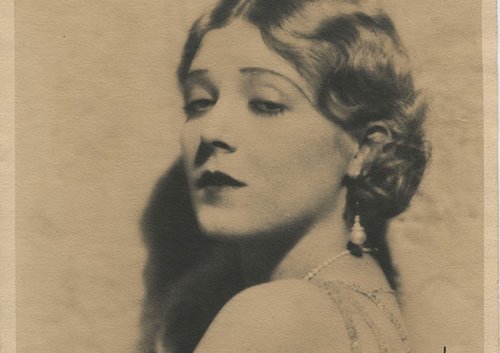
By Ellen Pullar
I am easily star-struck. I love movie stars. The glamour, the scandals, the larger-than-life “personalities,” the faces – carefully crafted out of light and pancake makeup, and resplendent in close-ups… Before taking up my job at the Film Archive I spent several years as a postgraduate student, researching classical Hollywood, basking in the still incandescent glow emitted by the stars of eighty years ago. Given my interests/fanaticism, I had been looking for an excuse to explore the Keri de Carlo Collection of old Hollywood star paraphernalia for some time, so I leaped at the chance to go and look through these materials for this blog.
The Keri de Carlo Collection is housed in the Film Archive’s Documentation Collection. De Carlo is a kiwi collector, who over some years acquired an impressive stash of photographs, letters and autographs of and from stars of Hollywood’s golden era (the odd European star has made it into his collection as well – there’s an autographed photo of Brigitte Bardot, for example). He patiently grew the collection over time by writing letters to Hollywood stars, who mailed their responses to him in New Zealand. Having gathered a substantial amount of material through the fan mail system, De Carlo then supplemented his collection by reaching out via newspaper ads to other New Zealanders with Hollywood star ephemera in their possession. In this way he attained earlier star materials, including photographs of stars active as far back as the 1910s – such as Pearl White, Billie Burke and the Talmadge sisters. In the current collection – which has been deposited at the Film Archive for safekeeping and to allow wider access to these materials by the New Zealand public – Mary Pickford, Katharine Hepburn, Clark Gable, Jean Harlow, Joan Crawford, Kim Novak, Charles Boyer, Bing Crosby, and Elizabeth Taylor are represented, along with many other iridescent stars of the classical era.
Looking through the many treasures in the Keri de Carlo collection, I was particularly struck by an autographed glamour portrait of 1920s starlet Vilma Banky. Banky looks every inch the movie star – from her backless and bejewelled evening dress, to the string of pearls, to her sultry, heavy-lidded facial expression.
Do you remember Vilma Banky?
Banky lived a lifestyle that echoed her glamorous screen roles. She married fellow film idol Rod la Roque and the two of them swanned about, enjoying the Hollywood high life.
Born in Nagydorog in 1898, Banky had enjoyed a successful career in the Hungarian and German film industries before coming to Hollywood in 1925. She was one of a string of stars that producer Samuel Goldwyn “discovered” overseas, imported to the United States, then subjected to the full Hollywood glamour makeover and publicity ballyhoo. Others included Evelyn Laye (from the UK), Anna Sten (from the Soviet Union) and Merle Oberon (India/UK).
Vilma dazzled. As The Los Angeles Times declared:
“Miss Banky is possessed of a radiant refinement and loveliness. She may indeed be hailed as a truly notable screen ‘find.’ She has a charm of presence and a spiritual beauty that is both charming and captivating.” – September 20, 1925.
But her career was cut short with the coming of sound from 1928. During the silent era foreign actors had been readily assimilatable into the Hollywood star system because their accents (and command of the English language) did not work as factors that limited the types of roles they could play. As a silent film star Banky had been offered a selection of roles comparable to her American-born Hollywood counterparts. A reviewer of Banky’s film The Dark Angel (1925), in which she played a British woman, remarked:
“[Banky is] more American or English in appearance than Hungarian; in fact one would never take her for a Hungarian, and it seems strange, when one talks to her, that her knowledge of English is so limited.” – New York Times, October 18, 1925.
Pity then that sound cinema spoiled this illusion of Banky on screen as multi-national, and exempt from ethnic stereotyping. After two unspectacular attempts at tackling English dialogue on film, Banky retired. Yet we can still admire her expressive face – which was so well-suited for silent cinema – in this beautiful image.
Hero image: Vilma Banky during the 1920s. Keri de Carlo Collection, Documentation Collection, New Zealand Film Archive Ngā Kaitiaki O Ngā Taonga Whitiāhua.